
The Christmas decorations are put away and the fireworks are finished, but the celebrating continues as Chinese Lunar New Year starts on Wednesday, January 29th, 2025. These free, fun Chinese New Year activities are sure to boost your students’ engagement and expand their horizons this semester!
This 23-day celebration is the perfect time to incorporate some Chinese New Year lesson plans into your schedule. To help with the planning process, we’ve included several inquisitive and engaging Chinese New Year activities designed to enhance your classroom instruction. Whether it’s developing student research skills, playing Chinese New Year games, or completing themed worksheets, we have it right here for you: bookmark this page as your go-to destination for Chinese New Year teacher resources!
We’ve also included a Chinese New Year literary passage with original Piqosity reading questions for students to try their hand at, as well as an original Piqosity math problem-set with a festive flair!
2025 is the Year of the Snake in the Chinese Lunar Calendar
Also called Spring Festival, Chinese New Year is the biggest holiday in Chinese culture, and it’s similar in scale to the holiday season in the United States between Thanksgiving and New Year’s Day. In 2025, people will start celebrating on January 23rd (Little New Year) and banks and government offices close for 7 days beginning on New Year’s Eve (January 28th). The holiday ends with the celebration of the Lantern Festival on February 12th.
The Chinese Zodiac calendar rotates between twelve animals, and 2025 is the year of the Snake. People born in the year of the Snake (2025, 2013, 2001, 1989, 1977, 1965, 1953, 1941…) are supposed to be wise, mysterious, and determined. If your Chinese Zodiac is the snake, it is said that this year will bring you luck and prosperity!
Just like in the United States for Thanksgiving and Christmas, Chinese families reunite for this major holiday. In fact the Chinese New Year is often referred to as the “biggest human migration on the planet” as more than 400 million people normally travel from school or work back to their hometowns to celebrate with their friends and family.
Traditional celebrations include setting off fireworks on New Years Eve (fireworks were invented in China) and eating lucky foods like fish, dumplings, and noodles.
- Eating fish is supposed to bring good fortune, because the Chinese Mandarin word for fish “鱼 yú” is pronounced exactly the same as the word for surplus or bounty, as in a bountiful harvest.
- Eating dumplings is supposed to bring wealth, because historically the shape of a dumpling also looked like that of a Chinese silver ingot.
- Eating noodles is supposed to represent long life, because they’re long in shape!
In Chinese Mandarin, you can wish someone a happy new year by saying “新年快乐 xīn nián kuài lè,” which means “Happy New Year” or ” 恭喜发财 gōng xǐ fā cái,” which means “may you have a happy and prosperous new year.” The festival period itself is generally referred to as “春节 Chūn Jié,” which means Spring Festival.
Chinese New Year Classroom Activities
We’ve curated this collection of classroom activities themed around Chinese New Year so that you can select which resource is right for your classroom! Educate your students about this important holiday, facilitate their explorations of the Chinese zodiac, and spread good luck and fortune with the help of these tools.
1. Chinese New Year Webquest
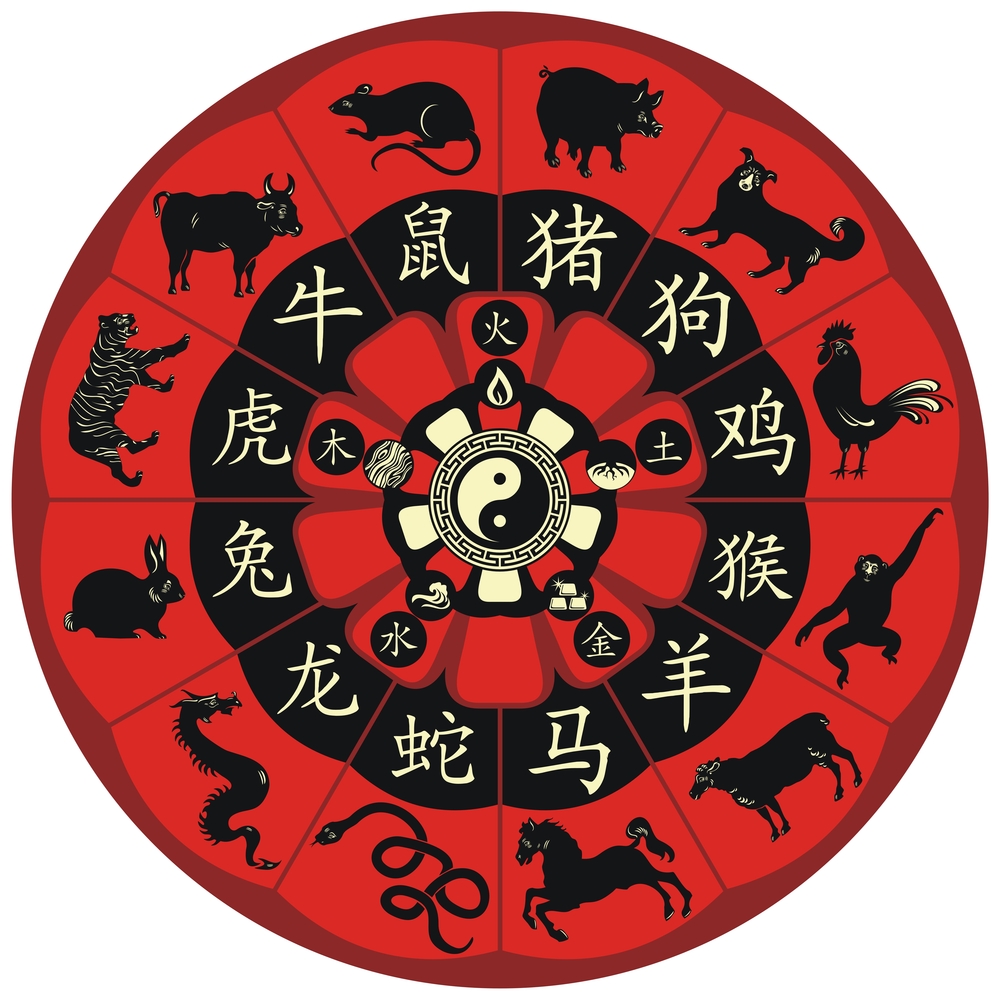 Sending your students on a Webquest is a great way to get them to practice their research skills. This webquest includes six pages of questions and prompts for students to explore; in searching for the correct answer(s) on the internet, students can develop their online research skills. This Webquest is aimed at at middle school students, and would pair perfectly with a lesson on how to use search engines for classroom research. Every question on the webquest relates to an aspect of Chinese New Year, with topics ranging from the history of the holiday to traditional practices, decor, and more!
Sending your students on a Webquest is a great way to get them to practice their research skills. This webquest includes six pages of questions and prompts for students to explore; in searching for the correct answer(s) on the internet, students can develop their online research skills. This Webquest is aimed at at middle school students, and would pair perfectly with a lesson on how to use search engines for classroom research. Every question on the webquest relates to an aspect of Chinese New Year, with topics ranging from the history of the holiday to traditional practices, decor, and more!
Created and made available for free download by Elizabeth Yu.
2. Chinese New Year Boggle and Other Activities
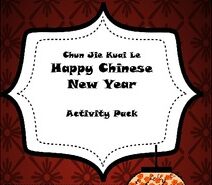 Our next set of Chinese New Year activities is this 10-page packet, which includes an introductory story about the 12 zodiac animals, a coloring sheet, word search, Boggle game activity, tangram activity, Chinese lantern activity, explanation of each zodiac animal and their corresponding years, a page of common Mandarin phrases, and a writing prompt to round it off! While some of the activities, particularly the crafts, are better suited for younger grades, these can easily be adapted to accommodate older students.
Our next set of Chinese New Year activities is this 10-page packet, which includes an introductory story about the 12 zodiac animals, a coloring sheet, word search, Boggle game activity, tangram activity, Chinese lantern activity, explanation of each zodiac animal and their corresponding years, a page of common Mandarin phrases, and a writing prompt to round it off! While some of the activities, particularly the crafts, are better suited for younger grades, these can easily be adapted to accommodate older students.
Created and made available for free download by From Chopsticks to Mason Jars.
3. Morning Math and Reading Warm Ups
These Chinese New Year math and reading activities are a great way to start the school day in your classroom. The packet includes 19 pages of themed activities focusing on reading comprehension and mathematics practice. These warm-ups are designed for students at a middle school reading and math level.
Created and made available for free download by EdHelper.
4. Chinese New Year Coordinate Map—Locate the Zodiac!
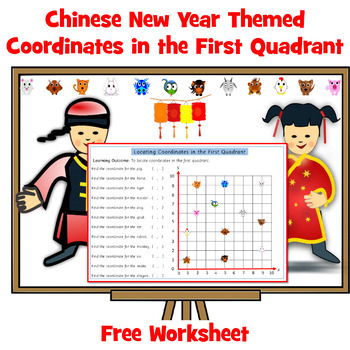 This activity is perfect for grade levels learning about coordinate planes, from 4th grade to even pre-Algebra. Students will be faced with a coordinate plane of the first quadrant that has the Chinese zodiac animals scattered throughout. Their task is simple—identify the coordinate location of each animal! A quick assignment for early finishers or a warm-up, this is a great way to refresh your learners’ knowledge of cordinate planes and the x- and y-axes after the winter break.
This activity is perfect for grade levels learning about coordinate planes, from 4th grade to even pre-Algebra. Students will be faced with a coordinate plane of the first quadrant that has the Chinese zodiac animals scattered throughout. Their task is simple—identify the coordinate location of each animal! A quick assignment for early finishers or a warm-up, this is a great way to refresh your learners’ knowledge of cordinate planes and the x- and y-axes after the winter break.
Created and made available for free download by Inspire and Educate.
5. Free Reading and Writing about Chinese New Year
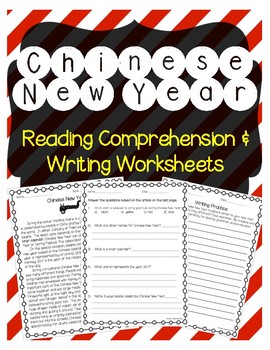 Our penultimate featured activity will help your scholars practice their reading comprehension and writing skills. This task includes a reading passage about Chinese New year and some cultural practices surrounding the holiday, such as wearing red and gold clothing to bring good luck or hanging up lanterns near the end of celebrations. After reading this passage, students will answer 5 reading comprehension questions to test their focus and newfound knowledge, followed by a writing excersize asking them to compare Chinese New Year traditions to their own New Years’ traditions. This ELA practice teaches students how to place themselves in a greater cultural context.
Our penultimate featured activity will help your scholars practice their reading comprehension and writing skills. This task includes a reading passage about Chinese New year and some cultural practices surrounding the holiday, such as wearing red and gold clothing to bring good luck or hanging up lanterns near the end of celebrations. After reading this passage, students will answer 5 reading comprehension questions to test their focus and newfound knowledge, followed by a writing excersize asking them to compare Chinese New Year traditions to their own New Years’ traditions. This ELA practice teaches students how to place themselves in a greater cultural context.
Created and made available for free download by Lisa’s Learning Shop.
6. Chinese New Year Zodiac Survey
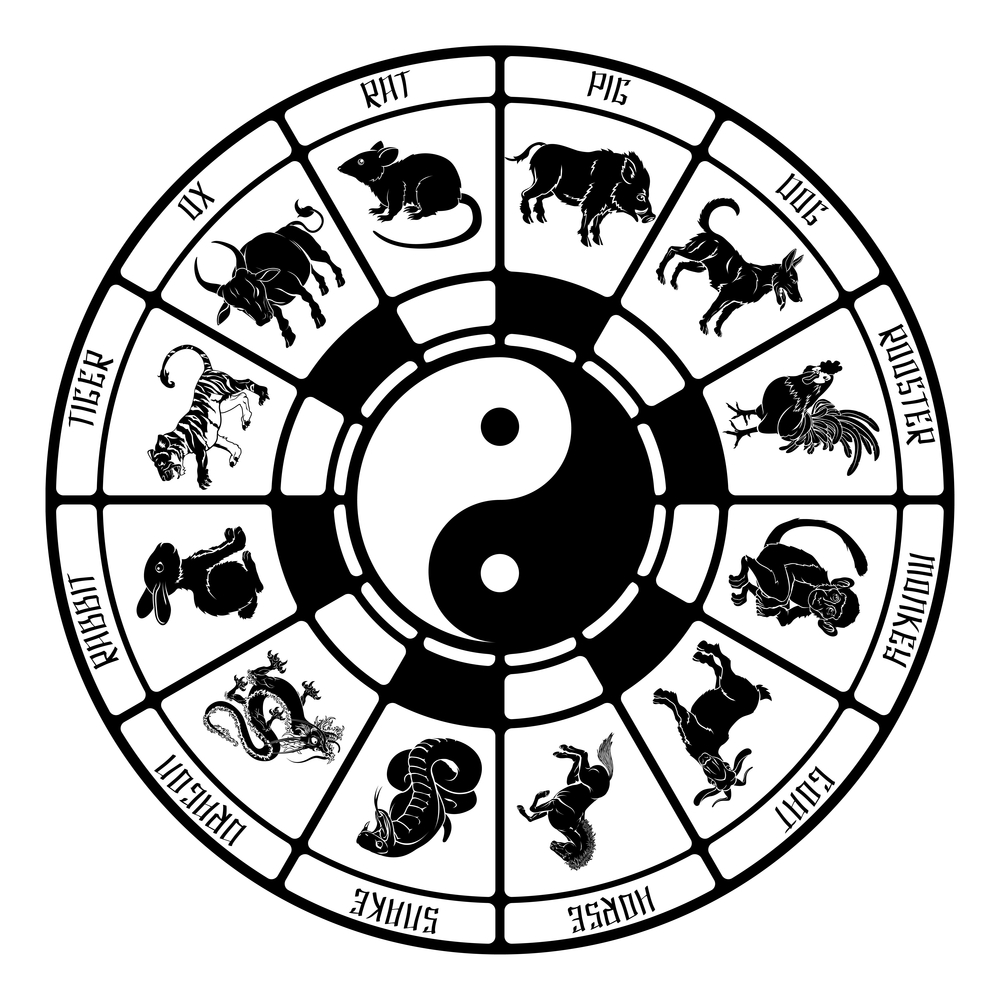 Our list of educator-created resources ends with a homework activity for students that prompts them to spend some time with family to celebrate this holiday. Since the Chinese zodiac changes by year, your students’ signs will have very little variation between each other; so, have your students explore this topic with their family! This activity will task them with asking other members of their family what year they were born—then, they will look at the attached chart for their corresponding zodiac animal. They’ll have a blast comparing with the family members closer in age to them and seeing how their family members’ zodiac animals compare to their personality!
Our list of educator-created resources ends with a homework activity for students that prompts them to spend some time with family to celebrate this holiday. Since the Chinese zodiac changes by year, your students’ signs will have very little variation between each other; so, have your students explore this topic with their family! This activity will task them with asking other members of their family what year they were born—then, they will look at the attached chart for their corresponding zodiac animal. They’ll have a blast comparing with the family members closer in age to them and seeing how their family members’ zodiac animals compare to their personality!
Created and made available for free download by Maggie Canniff.
Chinese New Year Reading Comprehension Questions by Piqosity
Our own Piqosity team has developed the following original reading comprehension questions, covering a variety of English Language Arts subtopics. In this passage, students will learn about the differences between Chinese New Year and Lunar New Year, explore the social perceptions of each holiday, and become familiar with aspects of Chinese astrology.
Chinese New Year Reading Passage: The Differences Between Chinese New Year and Lunar New Year
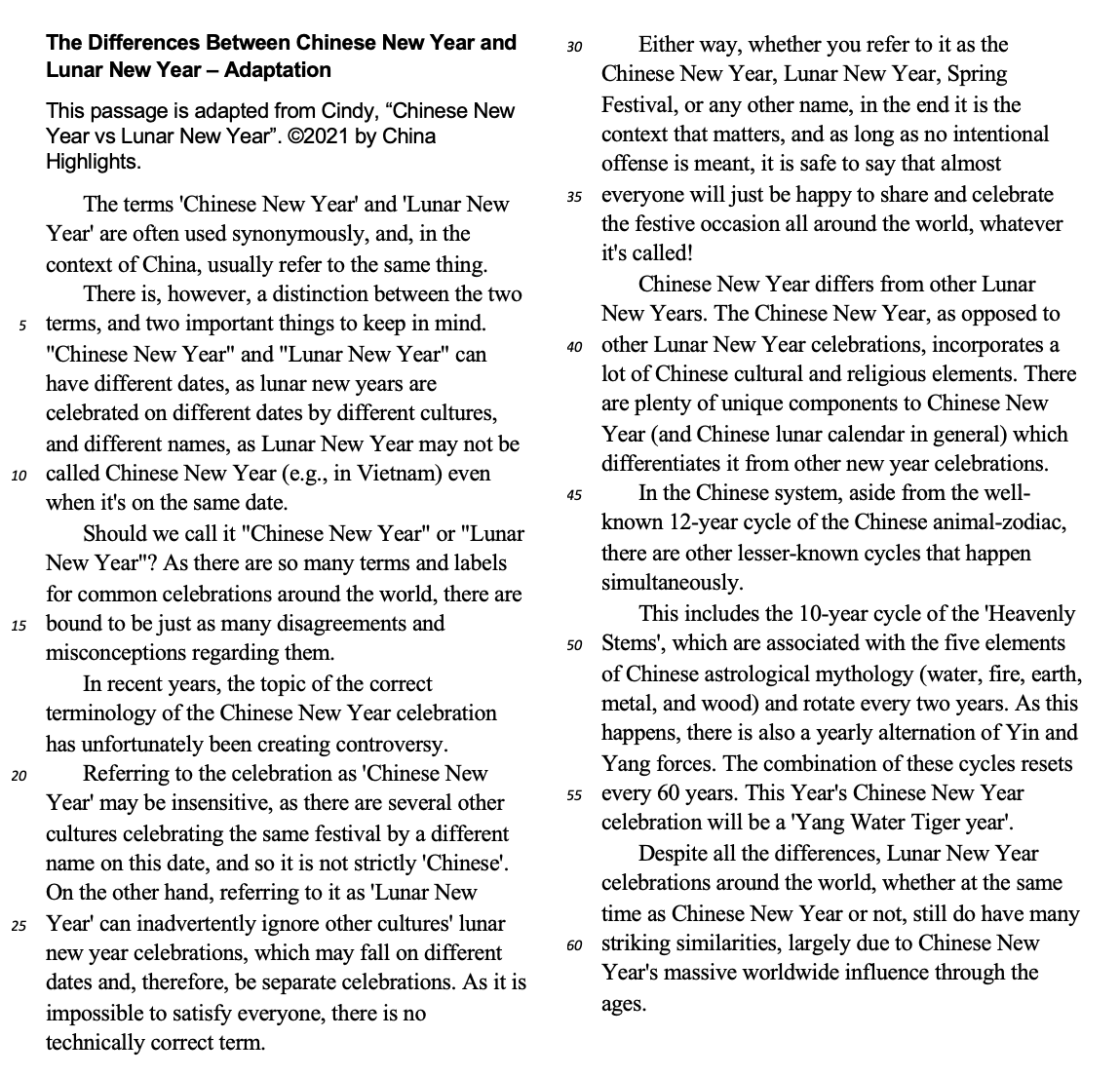
Reading Comprehension Questions
1. Which is not one of the five elements of Chinese astrological mythology that is associated with the “Heavenly Stems” cycle?
A. Water
B. Fire
C. Wood
D. Light
2. What is the most likely definition of the word “synonymously” (line 2)?
A. interchangeably.
B. differently.
C. neutrally.
D. ignorantly.
3. The flow of the elements goes: wood, fire, earth, metal, water. Each element has a Yang year then a Yin year before it switches to the next element. If 2025 is a year of the Snake and 2022 was a “Yang Water Tiger Year” (line 56), which answer choice best describes the year 2025?
A. Yang Wood Snake.
B. Yin Wood Snake.
C. Yang Fire Snake.
D. Yin Water Snake.
Passage Answer Key and Explanations
1. D
Light is not one of the five elements of Chinese astrological mythology. Lines 49–52 of the passage state that “fire, water, earth, metal, and wood” are the five elements.
2. A
The word “synonymously” is an adverb that most nearly means interchangeably. Words that are used synonymously are used as if those words are synonyms. The following statement of the passage says that the two holidays “usually refer to the same thing” (line 3). This context clue hints that the phrases are treated as though they are the same thing. However, just because words are used synonymously doesn’t mean they actually are synonyms, as the passage points out.
3. B
2025 is a Yin Wood Snake year. The question says that the flow of elements every other year goes wood, fire, earth, water, metal. Additionally, the passage states that “there is a yearly alternation of Yin and Yang forces” (lines 53–54). Since 2022 was a Yang Water year, and 2023 was a Yin Water year, 2024 switched to the next element, Wood. That means it was a Yang Wood Dragon year, and the new year will be Yin Wood Snake. The element after water is wood; as such, 2024-2025 are Wood Dragon and Snake. Since 2023 was a Yin year, 2024 was a Yang year, and 2025 is a Yin year.
Chinese New Year Math Questions by Piqosity
Piqosity’s team of math tutors has also developed the following Chinese New Year lesson to quiz students on a variety of mathematical skills. Pair these math questions with any of the activities mentioned in this article for the ultimate challenge!
1. If 
.
A. 6
B. 8
C. 10
D. 4.8
2. According to the Chinese Zodiac, the Year of the Snake repeats every 12 years. If it was the year of the Snake in 2001, which of these is also a possible year that could be a Year of the Snake?
A. 1997
B. 2023
C. 1991
D. 2012
3. Nian Gao is a traditional sweet rice cake eaten during the Lunar New Year. If 2 cups of sugar are required to make a batch of 24 rice cakes, how many cups of sugar are required to make a batch of 60 rice cakes?
A. 4.5 cups
B. 3.5 cups
C. 6 cups
D. 5 cups
Math Answer Key and Explanations
1. B
In this case, the lantern is used as a variable in our equation. We can find the value of the lantern by isolating it on one side of the expression.
To isolate the lantern, we need to divide both sides of the equation by 6.
2. A
In order for us to find the correct answer, we should evaluate each answer choice to see if the difference between it and the year 2001 is a multiple of 12 or not.
- If we subtract 2001 from 2012, we will find that there is a difference of 11 years between these two, so there is no possible way that the year 2012 is a Year of the Snake.
- If we subtract 2001 from 1991, we will find that there is only a difference of 10 years between these two, so there is no possible way that the year 1992 is a Year of the Snake.
- If we subtract 2001 from 2023, we will find that there is a difference of 22 years between these two. 22 is not a multiple of 12 so there is no possible way that the year 2023 is a Year of the Snake.
- If we subtract 2001 from 1977, we will find that there is a difference of 24 years between these two. Since 24 is a multiple of 12, we know that the year 1977 was also a Year of the Snake.
3. D
In order to solve for the number of cups required to make a 60 cake batch, we should set up a constant ratio using a variable and solve for the total amount of sugar required for the larger batch.
Solve for x, the number of cups of sugar required for a 60 cake batch. Before we think of cross multiplying, we should simplify the fraction on the left hand side.
This means that to make a 60 cake batch, we will need 5 cups of sugar.
Find More ELA and Math Resources Like These at Piqosity!
We hope you’ve enjoyed these FREE Chinese New Year activities, and we hope your students found this practice educational and fun. You can find more (non-themed) ELA and Math lessons with questions of similar difficulty levels in our ELA and Math Courses! These are complete courses available online through our app and can be purchased separately or received for free when bundled with our ISEE test prep courses!
Full-Length Math Courses:
- 5th Grade Math Course
- 6th Grade Math Course
- Pre-Algebra Course
- Algebra I Course
- Geometry Course
- Algebra II Course
- Pre-Calculus Course
Don’t forget to check out our collection of Chinese New Year Books!


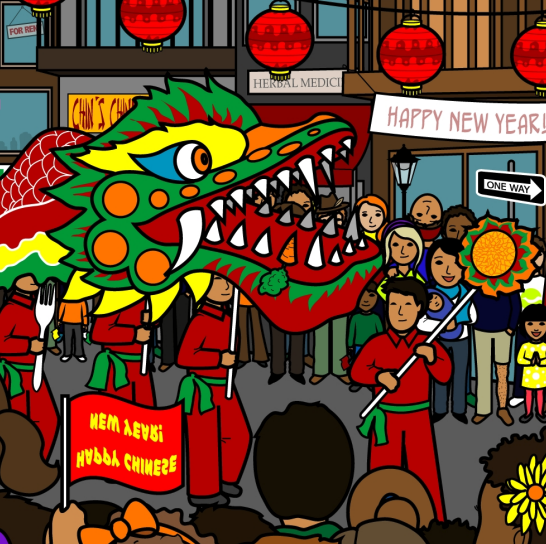


Leave A Comment